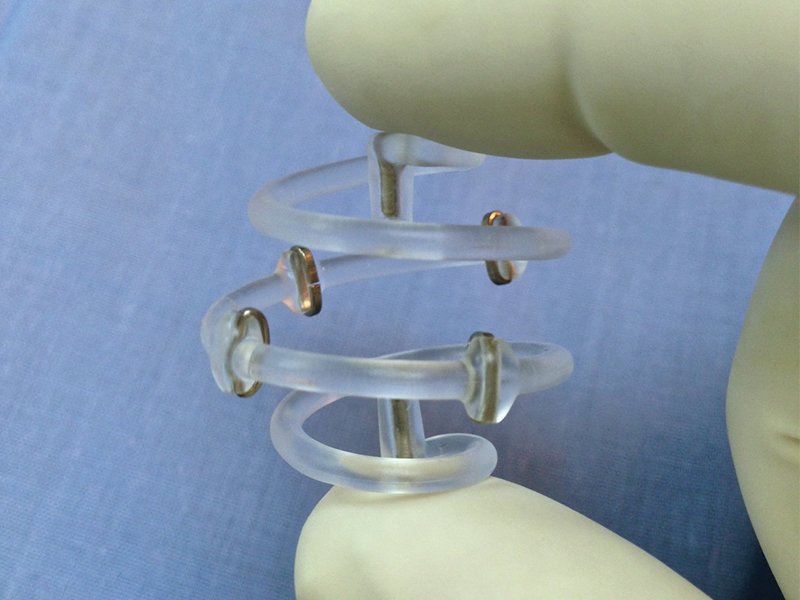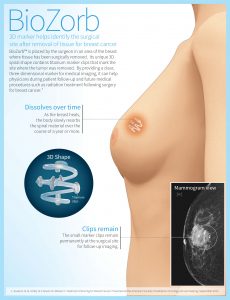BioZorb
There’s always a constant search going on for new and better ways to treat breast cancer.
Since the 1980s, radiation therapy has revolutionized breast cancer treatment, many times allowing women with early-stage cancer to keep their breasts. Such treatments involve surgery to remove the tumor, followed up with radiation to kill any stray cancer cells.
About 60 percent of the more than 200,000 women in the United States diagnosed with early-stage breast cancer each year undergo lumpectomy (also called breast-conserving) surgery with radiation.
Now, there’s a new device intended to improve the precision of those radiation treatments.
Biozorb, created by California company Focal Therapeutics, is a small, three-dimensional marker used in women with early-stage breast cancer. It provides a target for aiming radiation therapy at the tumor site, which helps minimize damage to healthy tissue.
The device, which was cleared for use by the U.S. Food and Drug Administration in 2012, was recently used for the first time in Hampton Roads at Bon Secours Cancer Institute at DePaul Medical Center in Norfolk, Virginia. Dr. Charles E. Ives, the Bon Secours surgeon who implanted BioZorb, believes it’s a device that will have significant benefits for women with breast cancer.
“It’s a simple device,” Ives says. “A simple idea. This is just one other thing we want the radiologist to have when deciding what’s most appropriate for a patient. The primary goal is to destroy the cancer.”
When a woman is diagnosed with breast cancer, there’s a team approach to treatment—involving an oncologist and a radiologist—to determine the best method of treatment depending on the stage of disease.
Some women aren’t interested in anything beyond surgery. They want the breast—and the cancer—gone. But breast-conserving therapy, which is the surgical removal of the cancerous tissue via lumpectomy followed by radiation therapy and sometimes also chemotherapy, has proven to be an effective treatment for women with early-stage breast cancer, according to Ives. It’s estimated that 75 to 80 percent of patients can be treated with breast-conservation therapy rather than mastectomy with excellent results, according to the Radiological Society of North America.
Radiation therapy is used after surgery to destroy any microscopic cells that might be left behind, to reduce the chance of reoccurrence. However, finding the exact spot where the lumpectomy was can be difficult. Once a tumor is removed, the area often fills up with fluid. While a radiation therapist can use the location of the fluid to know where to train a radiation beam, it still usually means treating the whole breast.
Enter BioZorb
The device is a walnut-sized coil that features six titanium clips arranged in a precise array. At the time of the lumpectomy, BioZorb is placed where the tumor was. A radiation oncologist later uses the location of those clips to know exactly where to direct the radiation beam. The device is eventually absorbed by the body over the course of about a year, but the clips remain. That makes it easier do follow-ups using routine mammograms.
There’s an extra benefit, too: surgeons have reported that the marker provides a structure for the breast tissue that helps preserve the natural contour of the breast, which historically can show some disfigurement after breast-conservation therapy.
“The new markers more clearly define the treatment area, allowing the radiation therapy team to confidently focus the treatments and safely reduce the amount of radiation needed to prevent reoccurrence,” says Dr. Bradley Prestidge, a radiation oncologist and regional medical director for radiation oncology with the Bon Secours Cancer Institute.
BioZorb isn’t considered a good option for women with late-stage breast cancer, or cancer that’s metastatic.
Norfolk resident Annie Heichel’s breast cancer was caught very early when her doctor suggested trying the BioZorb device. Heichel, who is 71, admittedly hadn’t been to a doctor in a while when she broke her ankle earlier this year. Because she had a different insurance company than the last time she had seen a doctor, she had to see a new provider for a physical. She was subsequently sent for a routine mammogram.
The mammogram found a lump in one breast and a shadow in the other. As it turned out, Heichel had cancer in both breasts. Once she heard the news, she figured she’d need mastectomies. She was surprised.
“They told me it was so early, I didn’t even need to consider that,” says Heichel, a mother, grandmother and great-grandmother who plans on staying around for her family for a good long while.
So in one breast, Heichel had a lumpectomy and a BioZorb placed. In the other, she had brachytherapy, in which little seeds of radiation were implanted to treat from within.
Following surgery, the radiation procedures were easy to deal with, without any pain or after-effects, Heichel says. After she finished one round of treatment, she rested just a few days before returning to her job as a front desk clerk at a Norfolk Howard Johnson’s.
“Everything they did was very exact,” Heichel says. “You didn’t have time to get distracted or worry. I’m very fortunate.”


